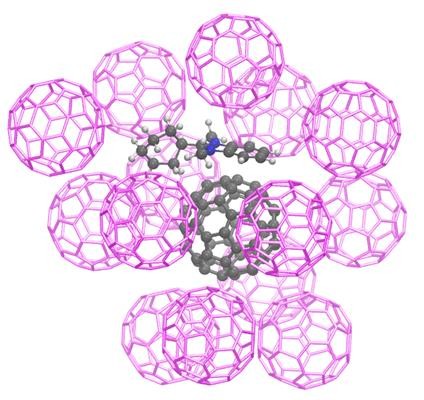Doping simulated in organic semiconductors

German and Japanese researchers have successfully demonstrated how the doping of organic semiconductors can be simulated and experimentally verified.
In semiconductor technology, doping refers to the intentional introduction of impurities (also known as dopants) into a layer or into the intrinsic semiconductor of an integrated circuit. These dopants are deliberate modifications of the semiconductor, with which the behaviour of the electrons and thus the electrical conductivity of the intrinsic material can be controlled. Even the smallest amounts of dopants can have a strong impact on the electrical conductivity. Electronic modifications by doping make semiconductors functional in all major electronic devices.
Although the principle of doping of conventional semiconductors was described in 1950 by US physicist John Robert Woodyard, there is still discussion about this process in organic semiconductors. This is because both the dopants and the semiconductor material consist of molecules, and the doping efficiency is affected by various factors that are not yet well understood. Physicists from TU Dresden, led by Dr Frank Ortmann, have now shown how different doping properties can be simulated and subsequently experimentally verified.
For the scientists’ purpose, the density of states and the Fermi level position of the prototypic materials C60 and zinc phthalocyanine (ZnPc), which were n-doped with highly efficient benzimidazoline radicals (2-Cyc-DMBI), were simulated and experimentally determined by direct and inverse photoemission spectroscopy. Conducted in collaboration with researchers from Japan, the goal of the research was to investigate the role of the electronic band gap states that are created upon doping.
The researchers identified the energetic difference Δ between the electron affinity of the undoped molecule and the ionisation potential of its doped counterpart (in the vicinity of dopants) as a key parameter for efficient doping. As noted by Dr Ortmann, “This parameter is critical for the generation of free charge carriers and thus influences the conductivity of the doped films.
“Strategies for optimising the electronic properties of organic semiconductors can be studied and characterised by changes in the value of Δ,” he added.
The study has been published in the journal Nature Materials.
Organic transistor 'limitation' improves stability
Researchers have shown that a longstanding organic transistor design limitation actually improves...
OLED circular polarisation is now electrically switchable
Researchers have discovered a way to control left- or right-handed polarised light via charge...
Nanoscale pixels to advance augmented reality eyewear
Physicists have developed extremely small pixels that can be used in compact AR glasses, using...




